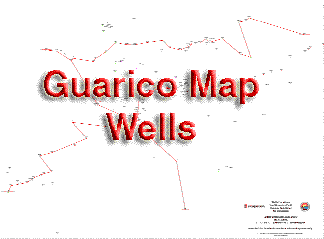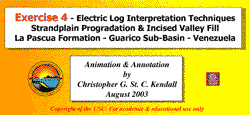EXERCISE 4
Objectives
The purpose of this exercise is to enable you to:
- Correlate wells using Spontaneous Potential and Resistivity well logs and a greater vertical spread of the La Pascua Section than in Exercises 1, 2 and 3.
- Subdivide the sedimentary section characterized by the well logs on the basis of the prominent correlatable surfaces (TS, mfs and SB) you can identify.
- Using these surfaces identify the parasequences within the sedimentary section characterized by the well logs and interpret the history of their evolving depositional settings.
- Describe the role of relative sea level in forming the resulting depositional settings utilizing the report on the geologic setting of the La Pascua Formation, the introduction to the sequence stratigraphy of the La Pascua Formation and the eustatic chart.
Data
 Pdf files containing wells logs and a base map can viewed on electronic media that include PC, Notebook, Tablet, or Pad. Exercises can be interpreted with Power Point. Power Point drawing tools, in particular "curve". This is an effective and easy way to handle the objectives of the exercise and a means for collective viewing of results in class. Click on red box for more details. The output can also be printed,on a large frame plotter and interpreted by hand. These exercise illustrations are quite large (up to 500K in some cases) and they may take a little time to be displayed. Patience will be rewarded!!!!
Pdf files containing wells logs and a base map can viewed on electronic media that include PC, Notebook, Tablet, or Pad. Exercises can be interpreted with Power Point. Power Point drawing tools, in particular "curve". This is an effective and easy way to handle the objectives of the exercise and a means for collective viewing of results in class. Click on red box for more details. The output can also be printed,on a large frame plotter and interpreted by hand. These exercise illustrations are quite large (up to 500K in some cases) and they may take a little time to be displayed. Patience will be rewarded!!!!
The clickable map below is linked to a pdf file which locates the five wells (me333, me296, me428, me313 and me 486) within the central portion of the Northern Strike Line

Methods
Utilize the Gulf Coast slip-slide method to help you match the log sections and identify the same geologic events on the various wells.
| Technique tying well logs to interpret clastic sedimentation on coast with valley incision. |
 |
 |
 |
Click on links above to view YouTube and QuickTime movies of the output of the identification of log character to correlated and interpret the logs. The best way to view the YouTube movie frames is to first click on the pause symbol on the control bar and then use the mouse to grab the thumb (red circle) on the red seekbar (this tracks the progress of the movie) and move the thumb back and forth to chosen frames and so gain a better understanding of the evolving sedimentary geometries.
In contrast the best way to view the QuickTime movies is to control their motion using the arrow keys on your keyboard.
- The left arrow will step the film back
- The right arrow will step it forward
Normally radioactive peaks ongamma ray logs, associated with mfs, are more extensive and would have been better correlation surfaces than the transgressive surfaces but gamma ray logs were not available for much of the Guarico Sub basin. As in the movie above you should use geologic logic to infer the location of the maximum flooding surface (mfs) and correlate these on all the well logs.
Thus as shown in the film make a cross-section first correlating the prominent silts for all the wells and then correlating the sands.
Pick base of massive sands and correlate these from well to well when they occur on other logs in other wells.
Identify the sequence boundaries (SB) at base of the massive sands and correlate these from well to well.
Identify all system tracts, including the incised valley, on all well logs.
For each ParaSequence which (bounded by mfs's) estimate and record the net sand (in feet).
Click on the thumbnial below to view the movie that tracks an interpretation of the character of the sedimentary fill of the Guarico Basin during the deposition of the La Pascua Formation.
| Well logs reveal evolving clastic sequence with valley incision subdivided into systems tracts. |
|
 |
 |
Click on links above to view YouTube and QuickTime movies of the output of the movie capturing the 3D perspective of the interpretation of the depositional setting from the well logs.
The best way to view the YouTube movie frames is to first click on the pause symbol on the control bar and then use the mouse to grab the thumb (red circle) on the red seekbar (this tracks the progress of the movie) and move the thumb back and forth to chosen frames and so gain a better understanding of the evolving sedimentary geometries.
In contrast the best way to view the QuickTime movies is to control their motion using the arrow keys on your keyboard.
- The left arrow will step the film back
- The right arrow will step it forward
Make a cross-section tying the silts and shales of all the wells and finally the sand geometries.
Provide an overall analysis that describes your conclusions.
As with the earlier four exercises (Exercise 1, Exercise 2, Exercise 3 and Exercise 5) to help with your interpretation of the well logs you should read the earlier sections related to the geologic setting of the La Pascua Formation and the introduction to the sequence stratigraphy of the La Pascua Formation. From these you will gain knowledge of the depositional setting of these rocks. You should combine the techniques outlined above with your understanding of the regional geology and the vertical and lateral facies relationships in near shore clastic settings (eg. shoreline, beach, stacked beaches, tidal flats, deltas) and Walther's Law. You should use these to build a depositional model and a sequence stratigraphic interpretation of the well log section.